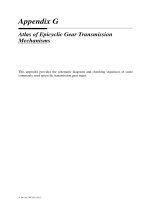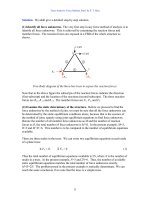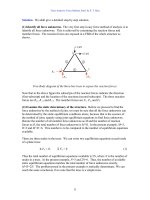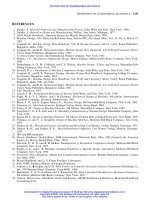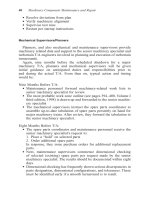ARNOLD, K. (1999). Design of Gas-Handling Systems and Facilities (2nd ed.) Episode 1 Part 3 pps
Bạn đang xem bản rút gọn của tài liệu. Xem và tải ngay bản đầy đủ của tài liệu tại đây (1.88 MB, 25 trang )
2-12,
oil
Inc.)
Heal
Transfer
Theory
37
where
q
sh
=
sensible heat duty,
Btu/hr
W =
mass
flow
rate,
Ib/hr
C =
specific heat
of the fluid,
Btu/lb-°F
T]
=
initial
temperature,
°F
T
2
= final
temperature,
°F
The
specific
heat
of
hydrocarbon vapors
and
liquids
is
given
by
Fig-
ures
2-13
and
2-14.
In
Chapter
6 of
Volume
1, it was
assumed that
C = 0.5
Btu/lb-
0
F
for
crude
oil.
It can be
seen
from
Figure
2-13 that this
is
true
for the
range
of
treating
temperatures
and
crude gravities normally encountered
in
oil
treating.
Latent
Heat
The
amount
of
heat energy absorbed
or
lost
by a
substance
when
changing
phases
is
called "latent
heat."
When steam
is
condensed
to
Figure
2-13.
Specific heats
of
hydrocarbon
liquids.
(From
Hoicomb
and
Brown,
/no*.
Ehg.
Chem.,
34,
595,
1942;
reprinted
from
Process
Heat
Transfer,
Kern,
McGraw-
HiflCo.,01950.}
38
Design
of
GAS-HANDLING
Systems
and
Facilities
Figure
2-14.
Specific
heals
of
hydrocarbon
vapors.
(From
Holcomb
ami
Brown,
/no.
£n§.
Chem.,
34,
595,
1942;
reprinted
from
Process Heat
Transfer,
Kern,
McGraw-Hill
Co.,
©1950.)
water,
the
temperature
doesn't
change,
but
heat must
be
extracted from
the
steam
as it
goes through
a
phase change
to
water.
To
change water
to
steam, heat must
be
added. When
a
substance changes
from
a
solid
to a
liquid
or
from
a
liquid
to a
vapor,
the
heat absorbed
is in the
form
of
latent
heat. This heat energy
is
referred
to as
latent heat because
it
cannot
be
sensed
by
measuring
the
temperature.
Heat
Transfer
Theory
39
where
q
lh
=
latent heat duty,
Btu/hr
W
=
mass
flow
rate,
Ib/hr
K
=
latent
heat,
Btu/lb
The
latent heat
of
vaporization
for
hydrocarbon compounds
is
given
in
Table 2-9.
The
latent heat
of
vaporization
of
water
is
given
by
h
fg
in the
steam
table (Table 2-6).
Heat
Duty
for
Multiphase
Streams
When
a
process
stream consists
of
more than
one
phase,
the
process
heat duty
can be
calculated using
the
following equation:
q
p
=
q
g
+ qo +
qw
(2-13)
where
q
p
=
overall
process
heat duty, Btu/hr
q
g
= gas
heat
duty,
Btu/hr
q
0
= oil
heat duty,
Btu/hr
q
w
=
water heat
duty,
Btu/hr
Table
2-9
Latent
Heat
of
Vaporization
Compound
Methane
Ethane
Propane
n-Butane
Isobutane
n-Pentane
Isopentane
Hexane
Heptane
Octane
Nonane
Decane
Heat
of
Vaporization,
1
4.696
psia
at
Boiling
Point, Btu/lb
219.22
210.41
183.05
165.65
157.53
153.59
147.13
143.95
136.01
129.53
123.76
118.68
40
Design
of
GAS-HANDLING
Systems
and
Facilities
Natural
Gas
Sensible
Heat
Duty
at
Constant Pressure
The
sensible heat
duty
for
natural
gas at
constant pressure
is:
where
Q
g
= gas flow
rate,
MMscfd
C
g
= gas
heat capacity,
Btu/Mscf
°F
Tj
=
inlet temperature,
°F
T
2
=
outlet temperature,
°F
Heat capacity
is
determined
at
atmospheric conditions
and
then
cor-
rected
for
temperature
and
pressure based
on
reduced pressure
and
tem-
perature.
where
C
= gas
specific heat
at one
atmosphere pressure,
Btu/lb-°F
(Figure
2-14)
ACp
=
correction factor
S = gas
specific gravity
The
correction factor
AC
p
is
obtained
from
Figure
2-15
where:
where
P
r
= gas
reduced pressure
P = gas
pressure,
psia
P
c
= gas
pseudo critical pressure, psia
Tj.
= gas
reduced temperature
T
a
= gas
average temperature,
°R = 1/2
(Tj
+
T
2
)
T
c
=
gas
pseudo
critical
temperature,
°R
The gas
pseudo critical pressures
and
temperatures
can be
approximat-
ed
from
Figure
2-16
or
they
can be
calculated
as
weighted
averages
of
the
critical
temperatures
and
pressures
of the
various components
on
a
Heat Transfer Theory
41
Figure
2-15.
Heat
capacity correction factor. (From
Chemical
Engineer's
Handbook,
5m
Edition,
R.
Perry
and C.
Chilton,
McGraw-Hill
Co.,
©
1973.)
mole
fraction
basis. Table
2-10
shows
a
calculation
for the gas
stream
in
our
example
field.
For
greater precision,
a
correction
for
H
2
S
and
CO
2
content
may be
required. Refer
to the Gas
Processors Suppliers Associa-
tion's Engineering Data Book
or
other
text
for a
correction procedure.
OH
Sensible
Heat
Duty
The
sensible heat
duty
for the oil
phase
is:
42
Design
of
GAS-HANDLING
Systems
and
Facilities
Figure
2-16.
Pseudo
critical
properties
of
natural
gases.
(From
Gas
Processors
Suppliers
Association,
Engineering
Data
Handbook,
9th
Edition.}
where
Q
0
= oil
flow
rate,
bpd
SG = oil
specific
gravity
C
0
= oil
specific heat,
Btu/lb-°F
(Figure
2-13)
Tt
=
initial
temperature,
°F
T
2
=
final
temperature,
°F
Water
Sensible
Heat
Duty
The
duty
for
heating
free
water
may be
determined
from
the
following
equation
by
assuming
a
water specific
heat
of
1.0
Btu/lb-°F.
where
Q
w
=
water
flow
rate,
bpd
Heat
Transfer
Theory
43
Table
2-10
Estimate
of
Specific
Gravity,
Pseudo
Critical
Temperature
and
Pseudo
Critical
Pressure
for the
Example
Field
CO,
N/
H
2
S
C,
C-,
d
iC
4
nC
4
iC
5
nC^
C
6
"
c-
Computed Value
Computation
Specific
Gravity
=
A
Mole
%
Gas
Composition
4.03
1.44
0.0019
85.55
5.74
1.79
0.41
0.41
0.20
0.13
0.15
0.15
100.00
Sum
(Aj)
19.48
_
'-^
-
o
67
—
—
\J,\J
1
29
B
Molecular
Weight
44.010
28.013
34.076
16.043
30.070
44.097
58.124
58.124
72.151
72.151
86.178
147
19.48
Sum
(Aj
x
B
{
)
Sum
(
Aj)
C
Critical
Temp.
°R
547.87
227.3
672.6
343.37
550.09
666.01
734.98
765.65
829,10
845.70
913.70
1112.0
374.6
Sum
(A,
x
Cj)
Sum
(Aj)
D
Critical
psia
1071.0
493.0
1036.0
667.8
707.0
616.3
529.
1
550.7
490.4
488.6
436.9
304
680.5
Sum
(Aj
xDj)
Sum
(A,)
Heat
Duty
and
Phase
Changes
If
a
phase change occurs
in the
process stream
for
which heat duties
are
being calculated,
it is
best
to
perform
a flash
calculation
and
deter-
mine
the
heat loss
or
gain
by the
change
in
enthalpy.
For a
quick hand
approximation
it is
possible
to
calculate sensible heat
for
both
the gas
and
liquid
phases
of
each component.
The sum of all the
latent
and
sensi-
ble
heats
is the
approximate
total
heat
duty.
Heat
Lost
to
Atmosphere
The
total
heat duty required
to
raise
a
substance
from
one
temperature
to
another
temperature
must include
an
allowance
for
heat
lost
to the
atmosphere during
the
process.
For
example,
if the
process
fluid flows
through
a
coil
in a
water bath,
not
only
is the
water bath
exchanging
heat
with
the
process
fluid, but it is
also exchanging heat with
the
surrounding
atmosphere.
44
Design
of
GAS-HANDLING
Systems
and
Facilities
The
heat lost
to the
atmosphere
can be
calculated
in the
same manner
as
any
other heat exchange problem using Equation 2-3,
The
overall
heat
transfer
coefficient
may be
calculated
from
a
modification
of
Equation
2-5,
By
assuming
that
the
inside
film
coefficient
is
very large compared
to the
outside
film
coefficient,
by
adding
a
factor
for
conduction losses
through
insulation,
and by
eliminating
fouling
factors
to be
conservative.
Equation
2-5
becomes;
where
h
()
=
outside
film
coefficient
Btu/hr-ft
2
-°F
= 1
+0.22V
W
(V
W
<
16
ft/sec)
=
0.53
V
W
°-
8
(V
W
>
16
ft/sec)
V
w
=
wind velocity
(ft/sec)
=
1.47x(mph)
AX}
=
shell thickness,
ft
K
{
=
shell thermal conductivity
Btu/hr-ft-°F
=
30 for
carbon steel (Table 2-3)
AX2
=
insulation thickness,
ft
K
2
=
insulation
thermal conductivity, Btu/hr-ft-°F
=
0.03
for
mineral wool
For
preliminary calculations
it is
sometimes assumed that
the
heat lost
to
atmosphere
is
approximately 5-10
% of the
process heat duty
for
unin-
sulated
equipment
and
1-2%
for
insulated
equipment.
Heat
Transfer
from
a
Fire Tube
A
fire tube contains
a flame
burning inside
a
piece
of
pipe which
is in
turn
surrounded
by the
process
fluid. In
this situation, there
is
radiant
and
convective
heat transfer
from
the flame to the
inside surface
of the
fire
tube,
conductive heat transfer through
the
wall thickness
of the
tube,
and
convective heat transfer
from
the
outside surface
of
that tube
to
the
oil
being
treated.
It
would
be
difficult
in
such
a
situation
to
solve
for the
heat
transfer
in
terms
of an
overall heat transfer coefficient. Rather, what
is
most often done
is to
size
the
fire tube
by
using
a
heat
flux
rate.
The
heat
flux
rate represents
the
amount
of
heat that
can be
transferred
from the
fire
tube
to the
process
per
unit area
of
outside surface
of the
fire
tube.
Common heat
flux
rates
are
given
in
Table
2-11.
Hear
Transfer
Theory
45
Table
2-
II
Common
Heat Flux
Rates
Medium
Being
Heated
Water
Boiling
water
Crude
oil
Heat
medium
oils
Glycol
Amine
Design
Flux
Rate
Btu/hr-ft
2
10,000
10,000
8,000
8,000
7,500
7,500
The
required
fire
tube area
is
thus
given
by:
For
example,
if
total heat duty (sensible heat,
latent
heat
duty,
heat
losses
to the
atmosphere)
was 1
MMBtu/hr
and
water
was
being heated,
a
heat
flux of
10,000
Btu/hr-ft
2
would
be
used
and
.100
ft
2
of
fire
tube
area would
be
required.
Standard
Burner
Btu/hr
100,000
250,000
500,000
750,000
1,000,000
1,500,000
2,000,000
2,500,000
3,000,000
3,500,000
4,000,000
5,000,000
Table
2-
12
Sizes
and
Minimum
Diameter
Minimum
Diameter-in.
2.5
3.9
5.5
6.7
7.8
9.5
11.0
12,3
13.5
14.6
15.6
17.4
*
46
Design
of
GAS-HANDLING
Systems;
and
Facilities
For
natural
draft
fire
tubes,
the
minimum
cross-sectional area
of the
fire
tube
is set by
limiting
the
heat
release
density
to
21,000
Btu/hr-irr.
At
heat release densities above
this
value,
the flame may
become
unsta-
ble
because
of
insufficient
air.
Using
this
limit,
a
minimum,
fire tube
diameter
is
established
by:
where
d
—
minimum
fire
tube diameter,
in.
In
applying Equation 2-22 note that
the
burner heat release density will
be
somewhat higher than
the
heat duty, including losses used
in
Equation
2-21,
as a
standard burner size will
be
chosen slightly larger than that
required.
Standard
burner sizes
and
minimum
fire tube diameters
are
included
in
Table
2-12.
CHAPTER
3
Heat Exchangers
*
HEAT
EXCHANGERS
Heat exchangers used
in gas
production facilities
are
shell-and-tube,
double-pipe,
plate-and-frame,
bath-type, forced-air,
or
direct-fired.
In
this
chapter
we
will discuss
the
basic concepts
for
sizing
and
selecting
heat
exchangers. This
is
just
a
brief overview
of
this complex subject
and is
meant
to
provide
the
reader with
a
basis upon which
to
discuss specific
sizing
and
selection details with heat exchange experts
in
engineering
companies
and
with vendors.
Bath-type heat exchangers
can be
either direct
or
indirect.
In a
direct
bath exchanger,
the
heating medium exchanges heat directly with
the
fluid
to be
heated.
The
heat source
for
bath heaters
can be a
coil
of a hot
heat
medium
or
steam, waste heat exhaust
from
an
engine
or
turbine,
or
heat
from
electric immersion heaters.
An
example
of a
bath heater
is an
emulsion
heater-treater
of the
type discussed
in
Volume
1.
In
this case,
a
fire
tube immersed
in the oil
transfers heat directly
to the oil
bath.
The
calculation
of
heat duties
and
sizing
of
fire
tubes
for
this type
of
heat
exchanger
can be
calculated
fom
Chapter
2.
^Reviewed
for the
1999
edition
by Lei Tan of
Paragon Engineering Services,
Inc.
47
48
Design
of
GAS-HANDLING
Systems
and
Facilities
In
an
indirect bath heat exchanger,
the
heating medium provides heal
to an
intermediary
fluid,
which
then
transfers
the
heat
to the
fluid
being
heated.
An
example
of
this
is the
common line heater used
on
many
gas
well
streams
to
keep
the
temperature above
the
hydrate
formation
tem-
perature.
A
fire
tube
heats
a
water bath,
which
provides heat
to the
well
stream
flowing
through
a
coil
immersed
in the
bath. Details
pertaining
to
design
of
indirect
bath heaters
are
presented
in
Chapter
5,
SHELL-AND-TUBE
EXCHANGERS
Shell-and-tube
heat exchangers
are
cylindrical
in
shape, consisting
of a
bundle
of
parallel tubes
surrounded
by
an
outer casing (shell). Both
the
tube
bundle
and the
shell
are
designed
as
pressure containing elements
in
accordance with
the
pressure
and
temperature requirements
of the
fluids
that
flow
through each
of
them.
The
tube-side
fluid is
isolated
from
the
shell-side
fluid
either
by
gasketed joints
or by
permanent partitions.
The
Standards
of
Tubular Exchanger Manufacturers Association
(TEMA)
define
the
various types
of
shell
and
tube exchangers,
as
well
as
design
and
construction practices.
The
shell-and-tube
exchanger
is by far the
most common type
of
heat
exchanger
used
in
production
operations.
It can be
applied
to
liquid/liquid,
liquid/vapor,
or
vapor/vapor heat transfer services.
The
TEMA standards
define
the
design requirements
for
virtually
all
ranges
of
temperature
and
pressure that would
be
encountered
in an oil or gas
production
facility.
The
simplest type
of
shell-and-tube heat exchanger
is
shown
in
Figure
3-i.
The
essential
parts
are a
shell
(1),
equipped
with
two
nozzles
and
having
tube sheets
(2) at
both ends, which also serve
as flanges for the
attachment
of the two
channels
or
heads
(3) and
their respective channel
covers
(4).
The
tubes
are
expanded into both
tube
sheets
and are
equipped
with
transverse
baffles
(5) on the
shell
side
for
support.
The
calculation
of
the
effective
heat transfer surface
is
based
on the
distance between
the
inside
faces
of the
tube sheets instead
of the
overall tube length.
The
shell-and-tube
exchanger
shown
in
Figure
3-1 is
considered
to
operate
in
counter-current
flow,
since
the
shell
fluid flows
across
the
out-
side
of the
tubes. Often,
in
order
to
maintain
a
high enough tube
velocity
to
avoid
laminar
flow and to
increase heat transfer,
the
design
is
modified
so
that
the
tube
fluid
passes
through
a
fraction
of the
tubes
in two or
more
successive
"passes"
from
head
to
head.
An
example
of a
two-pass
fixed-tube
exchanger
is
shown
in
Figure 3-2.
Heat
Exchangers
49
Figure
3-2.
Fixed
head
1 -2
shell-and-tube
heat
exchanger.
An
exchanger
in
which
the
shell-side
fluid flows in one
shell pass
and
the
tube
fluid in two or
more passes
is
called
a 1-2
exchanger.
A
single
channel
is
employed with
a
partition
to
permit
the
entry
and
exit
of the
tube
fluid
from
the
same channel.
At the
opposite
end of the
exchanger
a
bonnet
is
provided
to
permit
the
tube
fluid to
cross
from
the
first
to the
second pass.
As
with
all
fixed-tubesheet exchangers,
the
outsides
of the
tubes
are
inaccessible
for
inspection
or
mechanical cleaning.
The
insides
of
the
tubes
can be
cleaned
in
place
by
removing only
the
channel cover
and
using
a
rotary cleaner
or
wire
brush.
Baffles
Shell-and-tube
exchangers contain several types
of
baffles
to
help
direct
the flow of
both tube-side
and
shell-side
fluids.
Pass partition baf-
fles force
the
fluid to flow
through
several
groups
of
parallel
tubes. Each
of
these groups
of
tubes
is
called
a
"pass,"
since
it
passes
the fluid
from
one
head
to
another.
By
adding pass partition
baffles
on
each end,
the
tube-side
fluid
can be
forced
to
take
as
many passes through
the
exchanger
as
desired.
Transverse
baffles
support
the
tubes that pass through holes
in the
baf-
fle. The
transverse
baffle
cannot
go all the way
across
the
cross-section
of
the
shell, because
the
fluid
that
is in the
shell
has to be
able
to
come
50
Design
of
GAS-HANDLING
Systems
and
Facilities
over
the top of the
baffle
and
under
the
bottom
of the
next baffle,
etc.,
as
it
passes
across
the
tubes that
are in the
heat exchanger. When
it is
desired that
a fluid
pass
through
the
shell with
an
extremely
small
pres-
sure drop,
these
will usually
be
half-circle,
50%
plates that provide
rigid-
ity
and
prevent
the
tubes from sagging.
Transverse
baffles
can
help maintain
greater
turbulence
for the
shell-
side
fluid,
resulting
in a
higher rate
of
heat transfer.
The
transverse baf-
fles
cause
the
liquid
to flow
through
the
shell
at
right
angles
to the
axis
of
the
tubes.
This
can
cause
considerable
turbulence,
even when
a
small
quantity
of
liquid
flows
through
the
shell
if the
center-to-center distance
between baffles,
called
baffle spacing,
is
sufficiently small.
The
baffles
are
held
securely
by
means
of
baffle
spacers,
which consist
of
through-
bolts
screwed
into
the
tube
sheet
and a
number
of
smaller lengths
of
pipe
that form
shoulders
between adjacent baffles.
Transverse baffles
are
drilled
plates with heights that
are
generally
75%
of the
inside diameter
of the
shell. They
may be
arranged,
as
shown
in
Figure
3-3,
for
"up-and-down" flow
or may be
rotated
90° to
provide
"side-to-side"
flow, the
latter being desirable when
a
mixture
of
liquid
and
gas flows
through
the
shell. Although
other
types
of
transverse baf-
fles
are
sometimes used, such
as the
orifice
baffle
shown
in
Figure
3-4,
they
are not of
general importance.
Impingement baffles
are
placed
opposite
the
shell-side
inlet nozzle.
The flow
into
the
shell hits
the
impingement baffle
and is
dispersed
around
the
tubes,
rather
than impinging directly
on the top
tubes.
This
keeps
the
full
force
of the
momentum
of the
flow from impinging
on and
eroding
the top
tubes.
Longitudinal
baffles force
the
shell-side
fluid to
make more than
one
pass through
an
exchanger. With
no
longitudinal
baffle,
such
as in
Figure
Figure
3-3.
Transverse
baffle
detail.
Heat
Exchangers
51
Figure
3-4.
Orifice
baffle.
3-1,
the
shell-side
fluid
makes
one
pass
from
inlet
to
outlet. With
a
longi-
tudinal
baffle,
and
with
the
nozzles
placed
180°
around
the
shell,
the
shell-side
fluid
would
be
forced
to
enter
at the
left,
flow to the
right
to
get
around
the
baffle,
and flow to the
left
to
reach
the
exit nozzle. This
would
be
required
to
approximate true counter-current
flow,
which
was
assumed
in the
heat transfer equations
of
Chapter
2.
Tubes
Heat-exchanger
tubes should
not be
confused with
steel
pipe
or
other
types
of
pipe that
are
extruded
to
steel pipe
sizes.
The
outside
diameter
of
heat-exchanger tubes
is the
actual
outside diameter
in
inches within
a
very
strict tolerance. Heat-exchanger tubes
are
available
in a
variety
of
metals
including steel, copper, brass,
70-30
copper-nickel, aluminum
bronze, aluminum,
and
stainless steel. They
are
obtainable
in
several wall
thicknesses
defined
by the
Birmingham Wire Gauge
(B.W.G.),
which
is
usually
referred
to as the
B.W.G.
or
gauge
of the
tube. Table
2-1
shows
tube
outside diameter
and
B.W.G. gauge commonly used.
Tube
Pitch
Tube
holes
cannot
be
drilled
very
close
together, since this
may
struc-
tually
weaken
the
tube
sheet.
The
shortest distance between
two
adjacent
tube holes
is
called
the
"clearance."
Tubes
are
laid
out in
either square
or
triangular patterns
as
shown
in
Figure
3-5.
The
advantage
of
square pitch
is
that
the
tubes
are
accessible
for
external cleaning
and
cause
a
lower
pressure drop when shell-side
fluid flows
perpendicularly
to the
tube
axis.
The
tube
pitch
is the
shortest
center-to-center
distance between
adjacent
tubes.
The
common pitches
for
square patterns
are
%-in.
OD on
52
Design
of
GAS-HANDLING
Systems
and
Facilities
I
-in.
and
1-in.
OD on
l!4-in.
For
triangular patterns these
are
%-in.
OD on
%-in.,
M-in.
OD on
1-in.,
and
1-in.
OD
on
1/4-in,
In
Figure
3-5c
the
square-pitch layout
has
been rotated
45°,
yel
it is
essentially
the
same
as
Figure
3-5a.
In
Figure
3-Sd
a
mechanically
clean-
able modification
of
triangular pitch
is
shown.
If the
tubes
are
spread
wide
enough,
it is
possible
to
allow
the
cleaning
lanes
indicated,
Shells
Shells
up to
24-in.
OD are
fabricated
from
pipe using standard
pipe
nominal
diameters.
Standard pipe diameters
and
wall thicknesses
are
given
in
Volume
1,
Tables
9-5 and 9-9
(1st edition:
9-4 and
9-7),
Shells
larger than 24-in.
in
diameter
are
fabricated
by
rolling steel plate.
The
wall thickness
of the
pipe
or
plate used
for the
shell
is
normally
determined
from
the
American Society
of
Mechanical Engineers
(ASME) Boiler
and
Pressure
Vessel Code, TEMA standards also specify
some
minimum wall thicknesses
for the
shell.
Options
There
are
many different arrangements
of the
shells, tubes
and
baffles
in
heat exchangers. Figure
3-6 is a
list
of
TEMA standard classifications
for
heat exchangers, which helps
to
describe
the
various options. These
Figure
3-5.
Common tube layouts
for
shell-and-tube
heat
exchangers.
Heat
Exchangers
53
Figure 3-6. Heat exchanger nomenclature.
(From
Tubular Exchanger Manufacturers
Association,©
1978.)
54
Design
of
GAS-HANDLING
Systems
and
Facilities
are
best
understood
in
conjunction
with
the
example
configurations
given
in
Figures
3-7
through
3-9.
The
first
letter
designates
the
front
end of the
heat
exchanger,
the
sec-
ond
letter
designates
the
shell
type,
or the
middle
of the
heat
exchanger,
and
the
third
letter designates
the
back,
or the
rear,
of the
heat
exchanger.
An
AES
classification
for a
heat
exchanger
means
that
the
heat
exchanger
has a
channel
and
removable
cover
type
front
end.
The
cover
can
be
unbolted
to
perform
maintenance
and the
channel
can be
unbolted
without
pulling
the
tube
sheet.
The
"E"
designates
a
one-pass
shell.
The
shell
fluid
comes
in one end and
goes
out the
other.
The
rear
of the
heat
exchanger
is an
internal
floating
head.
The
head
can
move
back
and
forth
as
the
tubesheet
expands
and
contracts.
L
Stationary
Head—Channel
20.
Slip-on
Backing
Flange
2.
Stationary
Head—Bonnet
21.
Floating Head
Cover—External
3.
Stationary Head
Flange—Channel
or
Bonnet
22.
Floating Tubesheet
Skirt
4.
Channel Cover
23.
Packing
Box
5.
Stationary Head
Nozzle
24.
Packing
6.
Stationary Tubesheet
25.
Packing Gland
7.
Tubes
26.
Lantern Ring
8.
Shell
27,
Tierods
and
Spacers
9.
Shell
Cover
28.
Transverse Baffles
or
Support Plates
10.
Shell
Flange—Stationary
Head
End 29.
Impingement
Ptate
11.
Shell
Flange—Rear
Head
End 30.
Longitudinal Baffle
12.
Shell
Nozzle
31.
Pass
Partition
13.
Shell Cover Flange
32.
Vent Connection
14.
Expansion Joint
33.
Drain Connection
15.
Floating
Tubesheet
34.
Instrument
Connection
16.
Floating
Head
Cover
35.
Support Saddle
17.
Floating
Head
Flange
36.
Lifting
Lug
18.
Floating
Head Backing
Device
37.
Support Bracket
19.
Split
Shear
Ring
38.
Weir
39.
Liquid
Level
Connection
Figure 3-7. Heat exchanger components. (From
Tubular
Exchanger Manufacturers
Association,©
1978.)
Heat
Exchangers
55
Figure
3-8.
Heat
exchanger
components
(continued).
(From
Tubular Exchanger
Manufacturers
Association,
©
1978.)
If
there were
no
removable cover
on the
front
end of the
exchanger,
it
would
be
designated
"BBS."
The
second nozzle
and
pass partition
in the
front
end are
discretionary depending
upon
the
shell type. Types
A and B
bolt
onto
the
shell.
In
type
C, the
head cannot
be
unbolted
for
maintenance.
The
shell
types
are E, F, G, H, J, and K. E is a
one-pass shell.
The fluid
comes
in on one
side
and
goes
out the
other side.
F is a
two-pass shell
with
a
longitudinal plate
in it. The fluid in the
shell makes
two
passes.
56
Design
of
GAS-HANDLING
Systems
and
Facilities
Figure
3-9.
Heat
exchanger
components
(continued).
(From
Tubular
Exchanger
Manufacturers
Association,
©
1978.)
G is a
split
flow.
The
fluid comes
in and
goes both ways around
the
lon-
gitudinal
baffle
and
then exits.
H
is
very rare;
a
double split flow.
J is a
divided
flow.
K
is a
kettle type
reboiler,
which
is a
special type
and is
best explained
by
looking
at the
example
"AKT"
in
Figure
3-9.
Kettle
types
are
common where there
is a
boiling liquid
or
where
gas is
liberat-
ed
from
shell
fluid as it is
heated.
The
weir controls
the
liquid, making
sure
the
tubes
are
always immersed
in
liquid.
Gas
that
flashes
from
the
liquid
can
exit
the top
nozzle.
Many
of the
rear
end
types allow
the
head
to
"float"
as the
tube
bundle
expands
and
contracts.
Heat
Exchangers
57
Type
S is a
floating head type.
As the
tubes heat
up,
they expand.
As
they
expand,
the
floating head moves back
and forth, but the
pressure
seal
is not at
the
sliding joint.
The
pressure seal
is at the
fixed
shell joint
in
the
outer head, which contains
the
pressure.
The floating
head
floats
free
inside
the
pressure vessel
as the
tubes move. Types
P and W are
floating
heads where
the
movement
of the
head
effects
the
seal between
either
the
shell-side
or
tube-side
fluid and
atmosphere.
Type
U
indicates
the
tubes
are in a
U-shaped
bundle
and no
special
closure
is
needed
for the
rear end, other
than
the
shell
itself.
The
tubes
are
free
to
expand
or
contract. This
is by far the
least expensive type
of
floating
head.
Classification
In
addition
to the
type description code there
is
also
a
shorthand
that
is
used
for
classifying
heat exchangers.
The
first
element
of the
shorthand
is
the
nominal diameter, which
is the
inside diameter
of the
shell
in
inch-
es,
rounded
off to the
nearest
integer.
For
kettle
reboilers
and
chillers
(remember
the
kettle
has a
narrow
end and a fat
end),
the
nominal diame-
ter
is the
port
diameter
(the
narrow end) followed
by the
shell diameter,
each rounded
off to the
nearest integer.
The
second element
is the
nominal tube length
in
inches. Tube length
for
straight tubes
is
taken
as the
actual
overall
length.
For
U-tubes
the
length
is
taken
as the
straight length
from
the end of the
tube
to the
bend tangent.
The
third element
is a
three-letter code indicating
the
type
of
front
end,
shell,
and
rear end,
in
that order.
For
example,
a
fixed
tubesheet
exchang-
er
(the tubesheet does
not
expand
and
contract
as it
heats
and
cools)
with
removable
channel
and
cover, single-pass shell,
23M-in,
inside diameter
with
tubes
16 ft
long
is
denoted
as
SIZE
23-192
TYPE AEL.
A
pull-through,
floating
head, kettle-type reboiler having stationary head
integral
with
the
tubesheet, 23-in. port diameter
and
37-in. inside
shell
diameter
with
tubes
16
ft
long
is
denoted
as
SIZE
23/37-192
TYPE
CKT.
Selection
of
Types
In
selecting
an
exchanger,
one
must know
the
advantages
and
disad-
vantages
of
each type.
The
three
basic
types
of
shell-and-tube
exchangers
are
fixed
tube sheet,
floating
head,
and
U-tube. Table
3-1
summarizes
the
comparison
between
these three exchangers.
Table
3-1
Heat
Exchange
Summary
Heat
Exchanger
Type
Fixed
Tube
Floating
Head
U-Tube
Advantages
•
Least expensive
•
Fewer gaskets
•
Individual tubes
are
replaceable
•
Ability
to
handle dirty
fluids
and
high differential temperatures
s
Head
and
tubes
can be
mech-
anically
cleaned
•
Individual tubes
are
replaceable
«
Fairly
low
cost
may be
lower
than
fixed
tube
*
Can
handle thermal expansion
• No
internal
gasketed joint
*
Bundle
is
replaceable
Disadvantages
•
Cannot clean
or
inspect shell
*
Bundle
is
replaceable
•
Limited
to
temperature
difference
of
2QO°F
without costly shell
expansion
joint
9
Higher cost than
fixed
tube
«
Internal
gaskets
can
leak
*
Tube cannot
be
cleaned mechanically
•
Fewer tubes
can
be
installed
in a
given
diameter shell
*
Difficult
to
unbolt
the
flange
from
the end of
U-tube
8
Individual tubes
are not
replaceable
Remarks
• For
clean
shell
fluids and low
differential
temperature, most
comonly
used
*
Types
A and
L
heads
are
most
common
9
Types
B and M are for
large diameter
and
high pressure
8
Types
T and
W
are
least expensive
but
have
possibilities
of
shell fluids leakage
*
Type
P
head
is
most expensive; type
S is
intermediate
in
cost
*
Commonly used
for
high
differential
temperature
*
Minimizes possibility
for
contamination
of
tube
fluids
with
pressure shell
fluids
8
Types
B and U are the
most common
on
U-tube
Heat
Exchangers
59
Placement
of
Fluid
The
question always comes
up of
which
fluid to put
in
the
tubes
and
which
fluid
to put in the
shell. Consider placing
a
fluid
through
the
tubes
when:
1.
Special alloy materials
are
required
for
corrosion control
and
high
temperatures.
2.
Fluid
is at
high pressures.
3.
Fluid
contains vapors
and
non-condensable gases.
4.
Fluid
is
scale forming.
Consider
placing
a fluid
through
the
shell
when:
1.
Small pressure drops
are
desired.
2.
Fluid
is
viscous.
3.
Fluid
is
non-fouling.
4.
Boiling
service
is
desired.
5.
Fluid
has low film
rate
and is
non-fouling
(finned
tubes
can be
used).
Placing
the fluid
through
the
tubes
is
a
consideration when special
alloy materials
are
needed
for
corrosion control, because
the
materials
would
be
needed only
on the
tubes.
If the
corrosive material
is in the
shell, both
the
tubes
and the
shell would need
to be
protected with special
alloy.
If the
fluid
is at
high
pressure,
it
should
be put in
tubes because
tubes
can
contain high pressure much more cheaply
as
they
are
much
smaller
in
diameter than
the
shell.
The
low-pressure
fluid
would
be in the
shell.
If the fluid
contains vapor
and
non-condensable gases, heat transfer
will
be
greater
if it is
placed
in the
tubes.
If the fluid is
scale
forming
it
should
be in the
tubes, which
can be
reamed
out.
Similarly,
the fluid
should
be put in the
shell when small pressure
drops
are
desired.
There
is
less
of a
pressure drop going through
the
shell
than there
is in
going through
the
tubes.
If the fluid is
very viscous,
pres-
sure
drop
will
be
less
and
heat transfer improved
if it is
placed
in the
shell.
It is
harder
to
clean
the
shell than
it is the
tubes,
so the
non-fouling
fluid
should
be put in the
shell.
If
boiling
service
is
desired,
a
kettle
design
should
be
used
and the
boiling
fluid
should
be put in the
shell,
not
inside
the
tubes.
If the fluid has a low
film
rate
and is
non-fouling,
it can
be put in the
shell,
and
finned
tubes
can be
used
to add to the
U-value.
In
this
case,
the fluid
would have
to be a
non-fouling fluid; otherwise,
it
would
plug
the
fins.
60
Design
of
GAS-HANDLING
Systems
and
Facilities
TEMA
Glasses
and
Tube
Materials
TEMA
standards
provide
for two
classes
of
shell
and
tube
exchanger
qualities.
Class
C is the
less
stringent
and is
typically
used
in
onshore
applications
and
where
the
temperature
is
above
~20°F.
Class
R is
nor-
mally
used
offshore
and in
cold
temperature
service.
Table
3-2
shows
the
most
important
differences
between
a
Class
R and a
Class
C
TEMA
exchanger.
Table
3-3 is a
tube materials
selection
chart (the common
tube
materi-
als
to use for
different
kinds
of
services).
Standard
tube
lengths
are
either
20 ft or 40 ft
Table
3-2
TEMA
Classes
Major
Features
Corrosion allowance
Tube diameters
Square pitch cleaning lane
Min.
shell thickness
Transverse
baffle
and
support
plate
thickness
Min.
thickness longitudinal
baffles
Impingement
protection
required
Cross-over area
for
multi-pass
floating
heads
or
channels
Stress relieving
of
fabricated
floating
covers,
or
channels
Gaskets
in
contact with
oil
or
gas
Minimum
gasket width
Minimum
tube sheet thickness
Edges
of
tubesheet
holes
Pressure gauge
and
thermo-
wells
on flange
nozzles
Min.
bolt
diameter
R
%-inch
3
A,
1,
114,
I
1
/?
54-inch
R
greai
In
some cases
14-inch
22
v
~>
P
1/2
1.3
times
flow
area
through
tubes
of
one
pass
Required
Metal
jacketed
or
solid
metal
^-inch
Tube diameter plus
twice
corrosion
allowance
Chamfered
Required
for
certain
sizes
34-inch
C
Mfi-inch
14,
-M,
14,
-X
%,
I,
1J4,
I!/;
M&~inch
ter
than
C
R
greater than
C
1^-inch
v>
39
p"
2
1.0
times
flow
area
through
tubes
of
one
pass
Only
if
required
by
ASME
Metal jacketed
or
solid
material
14-inch
Factor
less than tube
diameter
plus
twice
corrosion allowance
Deburred
Must
be
specified
/i-inch
to
/4-inch



